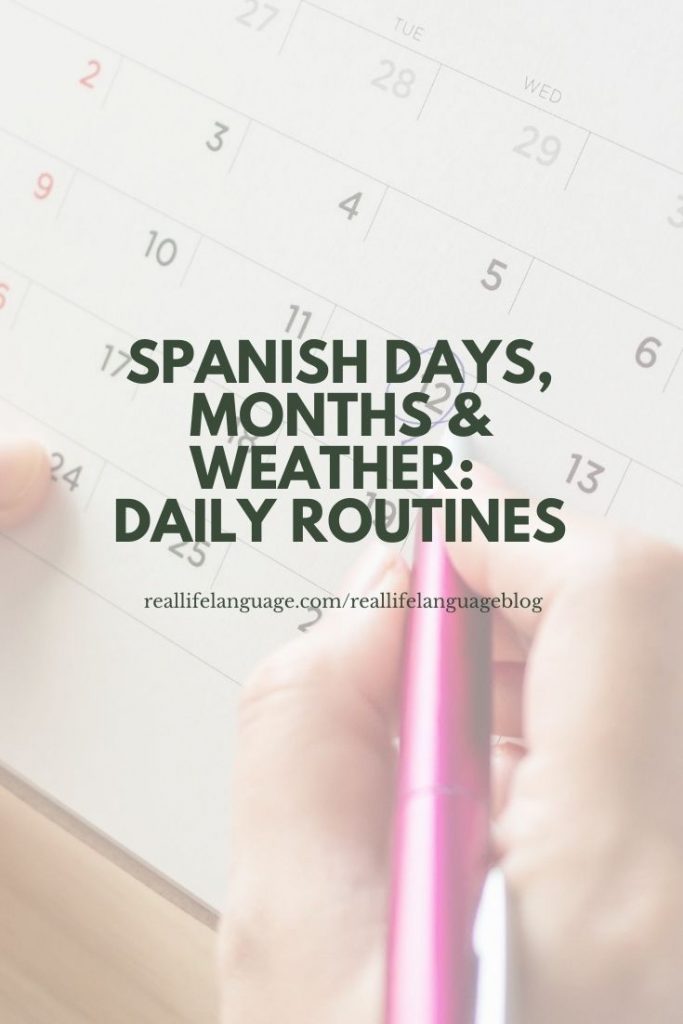I have published this content multiple times over many years. I wish I knew this when I was a beginning language teacher. This works in any language, too!
Use Spanish days, months and the weather as a part of your daily routine in class.
I came to public school teaching after working as a language instructor at a university and a private school. When my district invited Harry Wong, author of The First Days of School, I was thrilled to get some practical tips to be a more effective teacher in my new situation.
Wong said many things that resonate. He focuses on routines and procedures for the first two weeks. After everyone understands how a class works, the content easily falls into place.
This is PERFECT for a world language classroom. We get to teach our content through these routines and procedures.
During my years of teaching language immersion, kindergarten and Spanish in elementary, middle and high school, I have come to regard the calendar as an indispensable teaching tool. Math, weather, numbers, counting, seasons, days and months can all be taught via some time spent daily with the calendar.
Using the calendar daily in your secondary Spanish classes can greatly enhance your program as well. I have found that an investment of five minutes or less each day of class time has great returns. I am able to skip over the sections of my textbook that deal with these topics and the students are confidently proficient in talking about the language from the calendar. I find this helps me assign fun, immersive projects later in the year as well (i.e. weather reports, projects on seasons, etc.). These projects have also made for great sub plans when I have needed to be out and the students produce great products since they already know the vocabulary needed well. Students also receive an introduction to the past and futures tenses with this calendar work.
From the beginning of the year, I spend some time on the calendar and emphasize a different area each day. When I focus on a different section, I add an activity or two to help with the vocabulary. For example, this is a great place for a song, dance, rhyme or choral repetition- whatever you do to help your students remember the vocabulary.
I use a children’s calendar that I purchased from a department store in Spain. It is made of cloth with numbers, season icons, and weather icons. They can all be changed easily daily as they affix with Velcro to the calendar.
Spanish Days, Months and
Weather for Daily Routines
Los días:
Apart from repetition and songs we make up on the spot, I ask specific questions each day:
¿Qué día es hoy?
¿Qué día fue ayer?
¿Qué día será mañana?
¿Qué día fue anteayer?
¿Qué día será mañana?
¿Qué día será pasado mañana?
¿Cuántos días hay en una semana?
Los meses:
Again, we do lots of repetition here to learn the months. Some questions to go with the months:
¿Cuántos meses hay en un año?
¿Cuál es el mes después de ?
¿Cuál es el mes antes de ?
¿Cuáles son los meses del invierno?
¿Cuáles son los meses de la primavera?
¿Cuáles son los meses del verano?
¿Cuáles son los meses del otoño?
¿Cuáles son los meses del año?
La fecha:
This just comes with time. English-speaking students struggle with Spanish possessives, I find, so I adhere strictly to this method to teach the structure of the date.
After asking ¿Cuál es la fecha de hoy?, show them the structure on the calendar. We normally turn the question into a chant, repeating it several times. It really helps them get the question down.
Some questions to practice the date:
¿Cuál fue la fecha de ayer?
¿Cuál fue la fecha de anteayer?
¿Cuál será la fecha de mañana?
¿Cuál será la fecha de pasado mañana?
Las estaciones:
My calendar has icons to represent the different seasons. I am always sure to show at least two and say them when I ask ¿Cuál es la estación?, making the students select the correct season. After a short time, they will say the season with little prompting.
El tiempo:
My calendar also has icons for the weather. After asking ¿Qué tiempo hace?, give them choices of a couple of different kinds of weather.
Some questions to practice the weather:
¿Qué tiempo hace?
¿Qué tiempo hacía ayer?
¿Qué tiempo hace en invierno?
¿Qué tiempo hace en primavera?
¿Qué tiempo hace en verano?
¿Qué tiempo hace en otoño?
¿Hace calor?
¿Hace frío?
¿Hace viento?
¿Hace sol?
¿Está nublado?
¿Nieva?
¿Llueve?
¿Está nebloso?
¿Hace buen tiempo?
¿Hace mal tiempo?
¿Más o menos?
¿Está parte nublado parte soleado?
¿Hace fresco?
Looking for a calendar for your class, lessons and the questions?
-Printable calendar in Spanish for teaching months, days, weather and seasons each day (printable PDF and JPEG to use as a Power Point). Skip over this unit in your text!
12-page PDF printable calendar in Spanish to create your own
2 handouts for days and months
4 word puzzles for months, days and weather
Guide for using the calendar to teach Spanish
2 Weather and Seasons Power Points (one with sound)
Immersive Vocab Quizzes/Visuals
Weather and seasons handout
Weather and season mini-project
Spanish Calendar bundle to teach days, months, seasons and weather every day.
I also created a Google Slide version, too. Here it is: https://www.teacherspayteachers.com/Product/Google-Slide-Calendar-and-Questions-for-Spanish-Class-6537343
Looking for more ideas? Language Teaching: 5 Weeks of Low and No Prep Fun- Week 5
